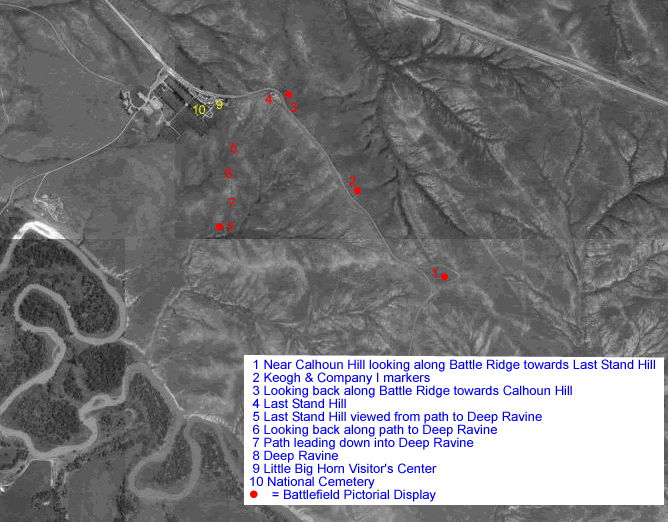


 |
  |
| Home>New Photos >Little Bighorn Battlefield |
Little Bighorn Battlefield Photos We visited the Little Bighorn Battlefield in June, 2004 one-hundred and twenty-eight years after Lt. Col. George Armstrong Custer and about 210 of his 7th Cavalry died on a hot afternoon on the dusty hills above the Little Bighorn River on June 25, 1876. The following overview photograph (courtesy of the USGS) has been annotated with links to photographs that I took at the Custer battlefield. Additionally, I have included some detailed high-resolution photos linked to the text where appropriate. I have recently added a scan of an old postcard with pictures of nine of the sixteen officers that died that day. The numbering of the Little Bighorn Battlefield photos follows the sequence of the Custer battle from the Calhoun Hill area through Captain Myles Keogh's battle area and back along Battle Ridge to the famous hill where Custer fell along with two brothers, a nephew, and many troopers. I have included a few photos of some of the pictorial displays alongside my numbered photos where applicable. Make sure you click on the number and the red-dots separately to see both items. From Custer's hill, the photos then proceed down a path leading to the Deep Ravine where troopers fled and died at the close of the battle. The details of the Custer battle sequence are subject to great controversy so please take my comments cautiously. Additionally, there are two links to photographs taken at the Little Bighorn Battlefield Visitor's Center and at the National Cemetery. |

|
The Little Bighorn Battlefield is unique in that the troopers were initially buried where they fell. Later, markers were placed to identify the locations. These white markers, again subject to some controversy, provide a clue to the battle locations. If you look closely at photo #1, you can see a scattering of white markers leading from the Keogh Company I fight all the way back to Last Stand Hill. (Here is an enlargement photo with the markers more visible in the middle ground before Last Stand Hill in the distance). In 1881, the trooper remains from all over the battlefield were moved to their final resting place near where Custer fell. A large monument stands there today. You can also see this monument in the distance above the teepee in photo #10. Our visit to the Little Bighorn Battlefield was something that I had wanted to do ever since I read Quentin Reynold's children's book "Custer's Last Stand" in the 1950s. In preparation, I read a number of books about the 1876 battle and visited a number of web sites. I wasn't surprised to learn that the Custer battle was still a matter of great, and sometimes heated, controversy. I spent most of my visit time touring the Custer battlefield because of this controversy and only made a short visit to the Reno-Benteen battlefield where it was easy to imagine the panicked Reno troopers scrambling up the bluff from the river after they fled the woods on the far side. I also stopped at Weir Point and wondered what Captain Thomas Weir saw as he looked out at the distant Custer Battlefield. I also looked up at the Crow's Nest where Custer and his scouts tried to discern what lay beyond them in the Little Bighorn Valley early in the morning of June 25, 1876. I recommend reading the following books if you want a good background on the Custer and Reno-Benteen battles.
The Fox and Michno books provide an excellent framework for understanding two opposing sides in the Custer controversy. The Gray book is a very detailed study that includes time-motion analysis to estimate the where and when of the troop movements. It also provides a history of scout Mitch Boyer. Connell's Son of the Morning Star is a classic that humanizes the players in this saga and forces the reader to view the events from the perspective of the 1870s instead of the comfortably politically correct viewpoints of today. |